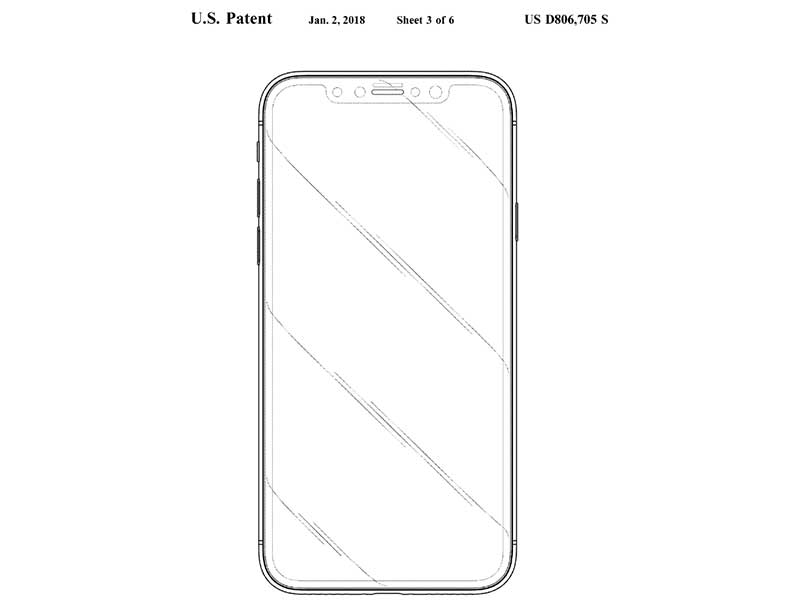As discussed elsewhere on the site, while many people imagine patents in terms of an object and how it functions, design patents cover how an invention looks. As the USPTO puts it, a design patent protects the “ornamental design embodied in or applied to an article of manufacture.”
Obviously, some common objects look quite similar in design, despite being made by different manufacturers. Smartphones are a good example. These days, they all look more or less like shiny black rectangles. But if you were to try and make a little money by making a cheap knockoff of the Apple iPhone X, you would quickly find yourself on the wrong end of a patent infringement lawsuit. That’s because the design of the iPhone X is protected by design patent D806,705.

The arrangement of the buttons, the notch at the top, the details of the bezel and edges, all come together to create a design instantly recognizable to Apple enthusiasts… and patent courts. Of course, that might only lead a determined entrepreneur to wonder, “How close could I get to emulating the look of the phone without getting myself into legal trouble?”
The infringement of design patents occurs when it becomes difficult for a consumer to recognize that a product isn’t what it emulates.
In the context of design patents, a claimed design is infringed upon when, “the resemblance [between the alleged infringing device and the claimed design] is such as to deceive [an ordinary] observer, inducing him to purchase on supposing it to be the other” [Gorham Mfg. Co v. White, 81 U.S. 511, 528 (1871)]. This has become known as the ‘ordinary observer test.’
The Court of Appeals for the Federal Circuit has elaborated on this (in Egyptian Goddess v. Swisa) by stating that precedent-setting cases of design infringement:
…are more properly read as applying a version of the ordinary observer test in which the ordinary observer is deemed to view the differences between the patented design and the accused product in the context of the prior art. When the differences between the claimed and accused design are viewed in light of the prior art, the attention of the hypothetical ordinary observer will be drawn to those aspects of the claimed design that differ from the prior art. And when the claimed design is close to the prior art designs, small differences between the accused design and the claimed design are likely to be important to the eye of the hypothetical ordinary observer.
What this means is that the ordinary observer test should be applied so that a patented design should be compared to prior art so that the unique distinctions in the latter can be readily picked out. Attention should then be turned to the allegedly infringing product to see if it features a significant number of these unique, patented characteristics.
The most critical aspect of design patent analysis is determining the strength of the design patent—how distinct it is from previous works.
A design patent is strongest when there is literally nothing like it in the prior art. In this case, prior art is everything that has ever been made, used, or sold prior to the critical date of the patent (the linked article explains at length how to determine a patent’s critical date).
However, most persons involved in potential infringement of a design patent are ignorant of the value of prior art. In fact, I know of exactly zero sellers who, in to responding to infringement allegations, have attempted to explain the breadth of the relevant prior art.
There are two issues that are important to consider when examining the prior art of a design patent:
- What is the closest thing to the patented design that is in the prior art?
- What is the closest thing to the alleged infringing design in the prior art?
I have a wall of letters and emails in my office from people who have retracted infringement notices after being confronted with nothing more than the prior art. Basically, if the claimed design or the alleged infringing design was in the prior art before the critical date, then there is no infringement liability. About 20% of the cases I handle have an incredibly strong prior art defense. It’s that easy, hence the wall of letters.
Oftentimes, sellers are actually in the best position to determine what is in the prior art. In addition to Amazon and Alibaba listings that are often very helpful, I often get shipping invoices from unrelated parties, photos with creation metadata dating back years ago, and so on. It’s all very useful information.
The trick is that a seller facing a design infringement lawsuit needs to know that this information is helpful to their case, which is why it’s wise to get the help of an experienced patent attorney. If you need assistance with an accusation of design patent infringement, the Law Office of Michael O’Brien can help. To learn more, contact us by calling (916) 760-8265, or send us a message using our contact form.
